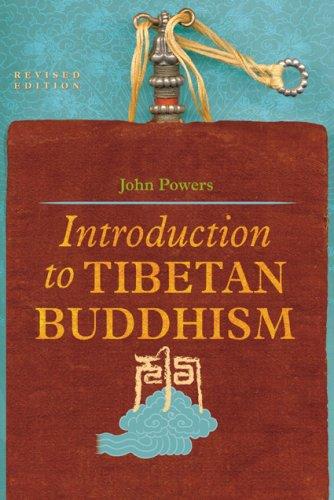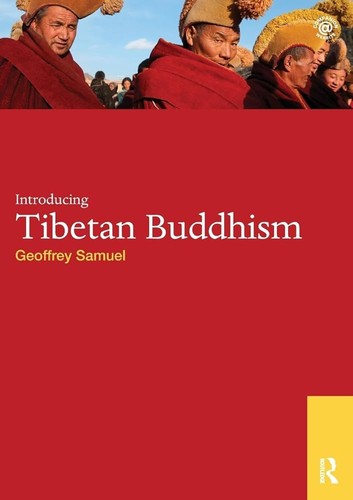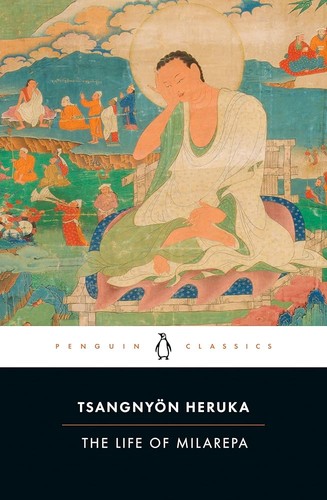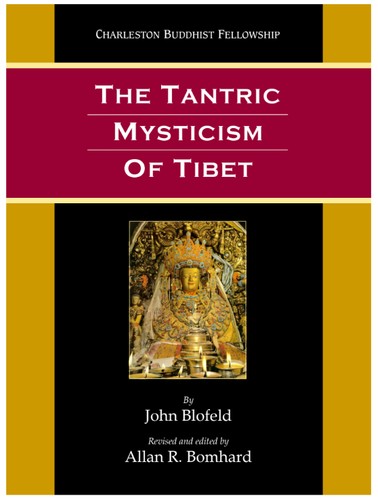Tibetan Buddhism
Subscribe to this topic via: RSS
Vajrayāna Buddhism came from medieval India, incorporating Inner Asia’s indigenous religions as it spread across the Tibetan Plateau to Mongolia and Bhutan.
Characterized by strong institutions and elaborate rituals, Tibetan Buddhism preserved much of the scholastic culture of late Indian Buddhism along with its esoteric and devotional practices which often center the figure of the guru, or “lama.” While Tibetan Buddhists recognize the validity of other forms of Buddhism, they usually feel that their Tantric practices are especially powerful and efficacious.

A group of red-robed monks share sodas and snacks at a monastery event in Kham in 2009. One monk is offering a drink to the lama, seated high and center, while the rest of the monks are lined up behind low tables on his left and right. The painted banners hanging overhead represent their main meditation practice: tantric visualizations which are considered dangerous without the guidance of a wise master. (Antoine Taveneaux, CC BY-SA 3.0)
Table of Contents
Books (11)
Featured:
-
557 pages
-
270 pages
-
236 pages
-
We meditate on ordinary mind by recognizing it as ordinary mind. We know it for what it is—empty and luminous.
-
In the teaching of my Guru, my mind is always happy.
Singing songs of inspiration, my mouth is always happy.
Wearing cotton from Nepal, my body’s always happy.
In delight I accomplish all and everything—
To me there is but cheer and joy.
See also:
Canonical Works (2)
Readings (68)
Featured:
-
🥇 Best of
“A monastery is a place where equality is preached but not practiced; a gar is a place where equality is practiced but not preached.”
-
⭐ Recommended
In Buddhist traditions, mindfulness is not limited to meditation; it applies to the entire path. Moreover, mindfulness cannot be regarded as something purely instrumental…
-
🥇 Best of
While many assume Treasure to be innovative, those developed Treasure tradition texts we inspected can, at least in their final published versions, better be described as conservative, and often extremely so.
-
The prospect of embodied divinity was not uncommon in Tibetan discourse and practice in general. The point is that this choice of terms forces the issue. To assert a human god’s ongoing karmic dependency is to define divinity and mortality in terms that are direct inversions of one another.
-
Tibetan Buddhism has long argued for the sanctity of life, condemning the killing of humans and animals alike. For just as long, however, meat has been a staple of the Tibetan diet. Individual religious leaders have dealt with this tension in different ways, but few have done so as revealingly as the eighteenth century master Jigmé Lingpa (‘jigs med gling pa, 1730-1798).
-
mGur (pronounced gur) denotes a specific type of religious poetry that has played an important role in the expression and transmission of Buddhism across the Tibetan cultural world. The term mgur is usually translated as ‘song’ and it has been used to refer to a wide variety of oral and literary creations.
-
Conflating religious practice with ethnic culture is considered to carry the risk of breeding “splittism” – especially in Tibet and Xinjiang. While in the post-Mao era the outright hostility against religion has given way to a religious revival, keeping religion and politics separate has remained a major concern for the Chinese Communist Party. Religion is supposed to be a private matter that does not interfere with politics. Against this backdrop, a recent phenomenon in the Tibet Autonomous Region is all the more remarkable: the (re-)fusion of ethnicity and religion under the label of cultural heritage and its protection.
-
Language is dealt with in Tibetan epistemological treatises in terms of the relationship between “what expresses” (rjod byed) and “what is expressed” (brjod bya)—two notions that come quite close to the Saussurian distinction between “signifier” and “signified.”
-
These Buddhist traditions are often labeled as “Tibetan,” as they are believed to have originated historically from Tibet, to share narrative traditions with Tibetan Buddhism, and to use Classical Tibetan as the language of their recorded canons. The organization of these traditions into what we might call “orders” is, however, complex in the Tibetan cultural world.
-
Among the nature-deities the tale under discussion depicts as confronting Padmasambhava, two (see below) are among the nine deities known as bod kyi srid pa chags pa’i lha, meaning the original deities of Tibet, whose function is to protect the land and people of Tibet.
-
One of the distinguishing features of Himalayan Buddhism is that it has accommodated within itself a good number of elements and traits of the pre-Buddhist indigenous religions and folk traditions.
-
One of Alak’s disciples, a 73-year-old ngakpa, explained in an interview the traditional (and previously pervasive) view about caterpillar fungus. He stated that the problem with collecting caterpillar fungus, from the Buddhist point of view, is that one cannot be sure when digging whether the caterpillar is actually dead or not. By killing the caterpillar, a collector may entail a breach of his or her vow to not kill any sentient being.
-
On the basis of initial observations [at Sera Jey Monastic University], we propose that successful debating requires skills that include reasoning and critical thinking, attentional focus, working memory, emotion regulation, confidence in your own reasoning skills, and social connectedness.
-
⭐ Recommended
Gelugpas, on the other hand, were antagonistic to other-emptiness, and in their Mahamudra system, the emptiness of mind that must be discovered through insight meditation is a negation pure and simple, without any implication that mind’s ultimate nature includes positive qualities, not even luminosity
-
Tibetan Buddhist philosophers interpret the doctrine of two truths—conventional and ultimate truths—as central to understanding reality, knowledge, and liberation. This Stanford Encyclopedia entry examines the different perspectives of Tibetan schools such as Nyingma, Kagyü, Sakya, and Gelug, highlighting their debates on the nature and relationship of these truths, all grounded in the Prāsaṅgika Madhyamaka tradition and the commentaries of Candrakīrti.
-
Early texts, like the Vimalaprabhā or the Lam yig of Man luṅ pa, do not describe Śambhala as a paradise on earth. They rather stress the spiritual qualities of the country and its inhabitants. Later works, especially the smon lam, the most popular texts on Śambhala among the Tibetan and Mongolian Buddhist lay people, concentrate on the paradisiac nature of the hidden kingdom.
-
In Ulan-Ude, the multi-ethnic, multi-religious capital of Buryatia, most laypeople make use of “Buddhist counseling” (Rus. priyom u lamy ), or various ritual, medical and other services that ameliorate illness and misfortune. Laypeople consult lamas about a range of issues from economic to familial matters, from imp attacks to joblessness. Such Buddhist counseling is one of the most common kind of interactions with Buddhist institutions and practices in Buryatia. At the same time, it is a deeply contested practice, as local critiques refer to the rise of “consumerist”, “commercialized”, “utilitarian” or “bad” Buddhism.
-
As long as one remains with a tenet system that accepts outer [objects], it is not tenable for the object and the [apprehending] consciousness to be of a single substance. In that case, the [object that is] the cause that casts an aspect [upon the consciousness] is called the apprehended object.
-
In Tibet sounds can heal, make ill, protect, challenge, appease, defile, purify, seduce or even liberate from worldly attachments. Sounds of the natural environment merge with human-made music and chanting in soundscapes that are intimately interconnected. While the spiritual features and healing powers of Buddhist ritual music have been often described, what is perhaps less known is the kaleidoscope of natural and human sounds against which it has been developed and performed for centuries. In this portfolio we explore some of these sacred soundscapes, their history and impacts.
-
female renunciation is a form of resistance to the norm which is household life, and a celibate jomo represents renunciation better than typically non-celibate Kinnauri male lamas do.
-
Since this is an extraordinary method for completing the transcendent perfections and pacifying obstacles anyone and everyone should take it to heart.
-
There are thus a great many systems of Dharma teaching in Tibet,
But aside from their nominal variations,
There is really no significant difference between them
All share the crucial point of seeking ultimate awakening. -
Tantra is an important part of the path to liberation in the Geluk tradition. It is a path to liberation that is held to involve distinct, esoteric methods, but without diverging from the philosophical view of emptiness, which is indispensable.
-
In the evening I crossed the river and started for home. Then I saw the corpse running on the other side of the river. It was completely naked, but carried its belt in one hand and its boots in the other. Then I saw a wolf coming after it, felling it to the ground.
-
Some experts think Beijing wants to bring Buddhist holy sites, like Tawang, under its control to cement its authority over Tibet. When the current Dalai Lama fled to India in 1959, he reached Tawang first after crossing mountains by foot.
-
Milarepa spent the rest of his adult life practicing meditation in seclusion and teaching groups of disciples mainly through spontaneous songs of realization (mgur).
-
Who is he and why is he so famous?
-
These days, however, if you consult followers of Mahāmudrā, Dzogchen and the like, they will not make even the slightest acknowledgement of instructions that suit people’s actual capacity, such as the way to progress in tranquillity and insight taught in the scriptural approach of the great pioneers.
-
Generally, even if we are attached to our own tradition, it is important that we have no antipathy towards other traditions.
-
Tsongkhapa saw the study and practice of such Indian classics as the Bodhisattvacaryavatara of Shantideva and the Ratnavali (Precious Garland) of Nagarjuna as highly supportive to an individual’s path to Buddhahood.
2 pages -
Thus, the particular feature of the Kagyu lineage is that the teacher, having mastered the instructions, clears away defects - relating to intellectual understanding, meditation experience and the various levels of realisation.
2 pages -
It is through the generosity of King Trisong Detsen, the monastic ordinations given by the abbot Shantarakshita, and the spiritual transmissions given by Guru Padmasambhava, that the Buddhist tradition was able to spread and flourish in Tibet from early times up to the present.
2 pages -
The Sakya Tradition has the distinction of having a close connection with the other three major schools of Tibetan Buddhism. The Vajrakila lineage, which the Sakyapas follow, originates from Guru Padmasambhava, the founding master of the Nyingma school. The Kagyu and the Sakya schools originated almost at the same time, and both received important lineages from Naropa.
2 pages -
Seemingly, we might have boundless knowledge, all derived from study and reflection, but if our fundamental character is not attuned to the Dharma, we will not tame the enemy, the destructive emotions.
-
Single embodiment of all the buddhas’ compassion,
Lotus King, chief of all sky-faring ḍākas and ḍākinīs,
Miraculously born nirmāṇakāya, untainted by a womb —
To this great eternal bearer of the lotus, I bow down! -
the abbot Shadeu Trulshik wrote down whatever came to mind and offered it from Māratika cave.
-
the vows of a bhikṣu,
The root of the teachings,
guard them as you would your very own eyes. -
Jamyang Khyentse Chökyi Lodrö’s advice to his wife Khandro Tsering Chödrön on how to live the Dharma.
-
The inconceivable qualities of this sacred place
I have sung in the form of a joyful song.
I have spoken of them as an oral instruction. -
May he free the kind ones immersed in misery’s ocean
So that all may come to resemble Mañjughoṣa himself. -
Bless me, so everything that obstructs the attainment of enlightenment may be pacified
-
So, like children of the same father and same mother,
Cultivate mutual accord, devotion, and pure perception,
And, while focusing on your own tradition, avoid belittling others.
See also:
Audio/Video (27)
Featured:
-
The lecture explores the symbolism, function, and spiritual significance of key ritual implements used in Tibetan Buddhist practice, such as vajras, bells, mandalas, and offering bowls. Drawing on his expertise in Tibetan art and religious traditions, the speaker situates these objects within their ritual, doctrinal, and cultural contexts to reveal how they embody and facilitate Buddhist teachings.
-
⭐ Recommended
Khunu Lama (1895–1977) was a master scholar and strict renunciant who was also a teacher to many of the twentieth century’s most famous masters, including His Holiness the 14th Dalai Lama. In this interview about his life, Annabelle Pitkin reflects on the tension between solitude and connection in the lives of Tibetan, Buddhist monastics.
1h 21 m -
⭐ Recommended
How did the Geluk school come to dominate Tibetan Buddhism?
1h 12 m -
⭐ Recommended
What is the “otherwise” of modernism in Mongolia and Inner-Asia?
64 min -
 56 min
56 min -
 54 min
54 min -
⭐ Recommended
 22 min
22 min -
In this episode, Naomi Worth discusses her journey through Tibetan Buddhism’s postural yoga, blending intensive retreat experiences with her role as a high school teacher. The conversation weaves together scholarship, practice, and the challenges of guiding teens in a modern world.
-
We are all backlit by completeness.
-
It’s the same vows, but the volume is turned up, if I may say so.
1h 16 m -
 26 min
26 min -
 21 min
21 min -
 15 min
15 min -
🥇 Best of
“As the tulku tradition developed, there was a lot of corruption. There were wars, and all sorts of things went on. But there was also a social structure that developed to contain that privilege.”
-
⭐ Recommended
This is thousands and thousands of times more important than my own life.
1h 43 m[recommended but under copyright]
See also:





